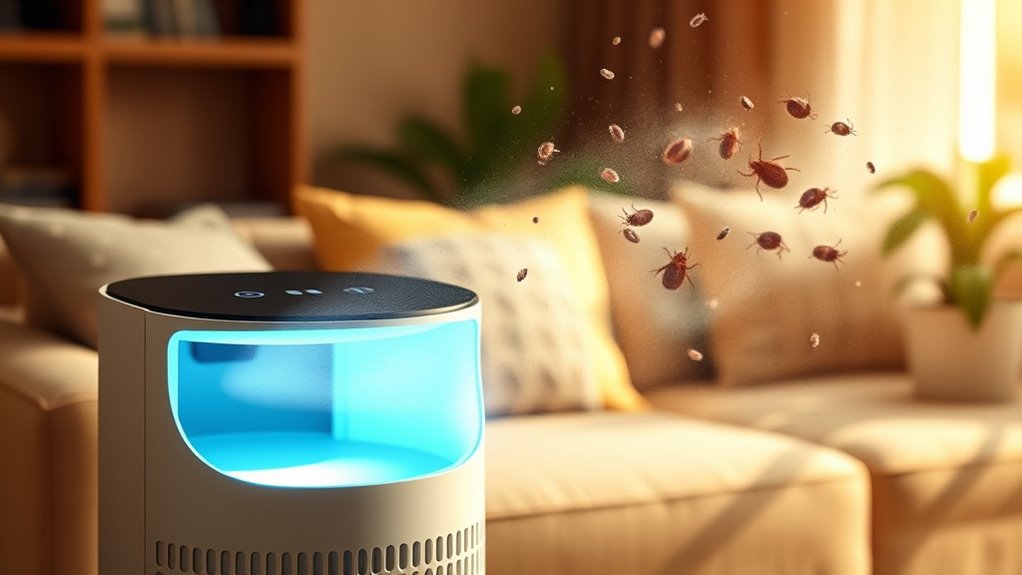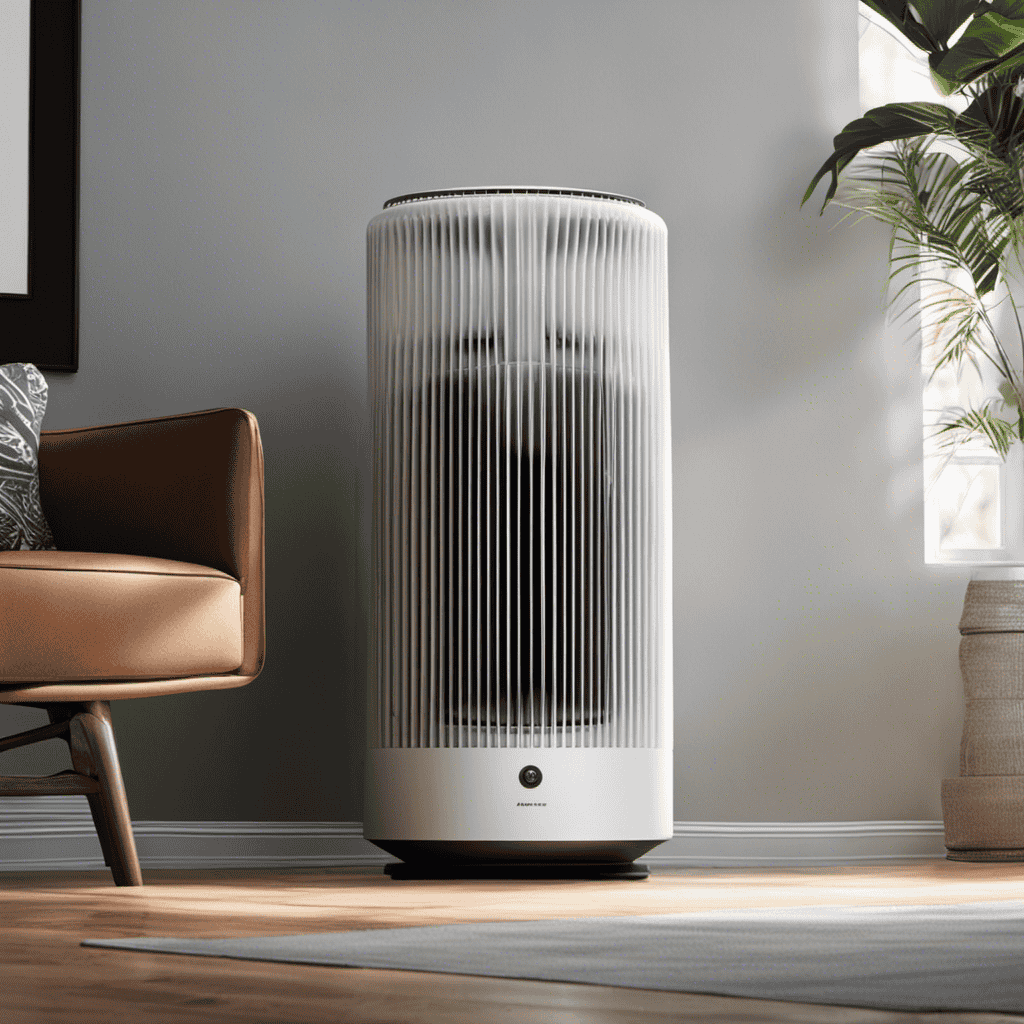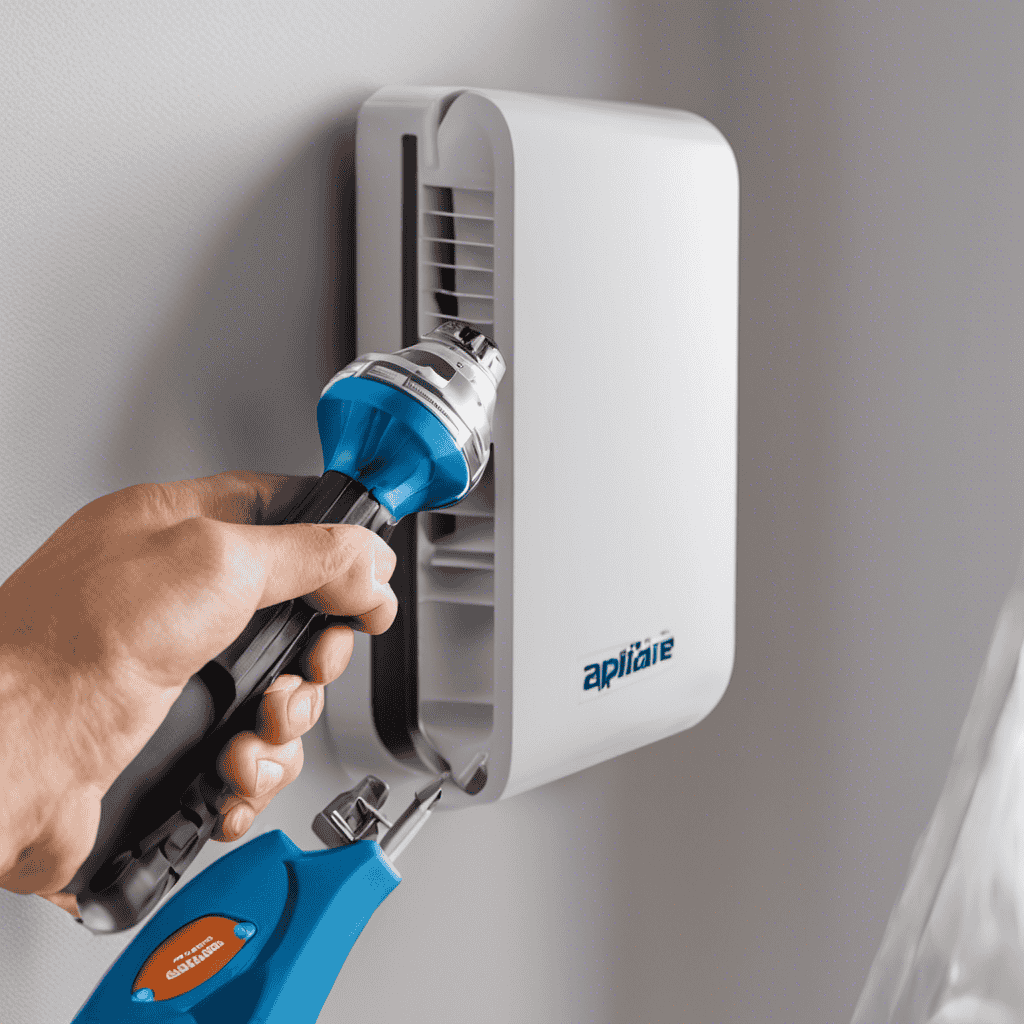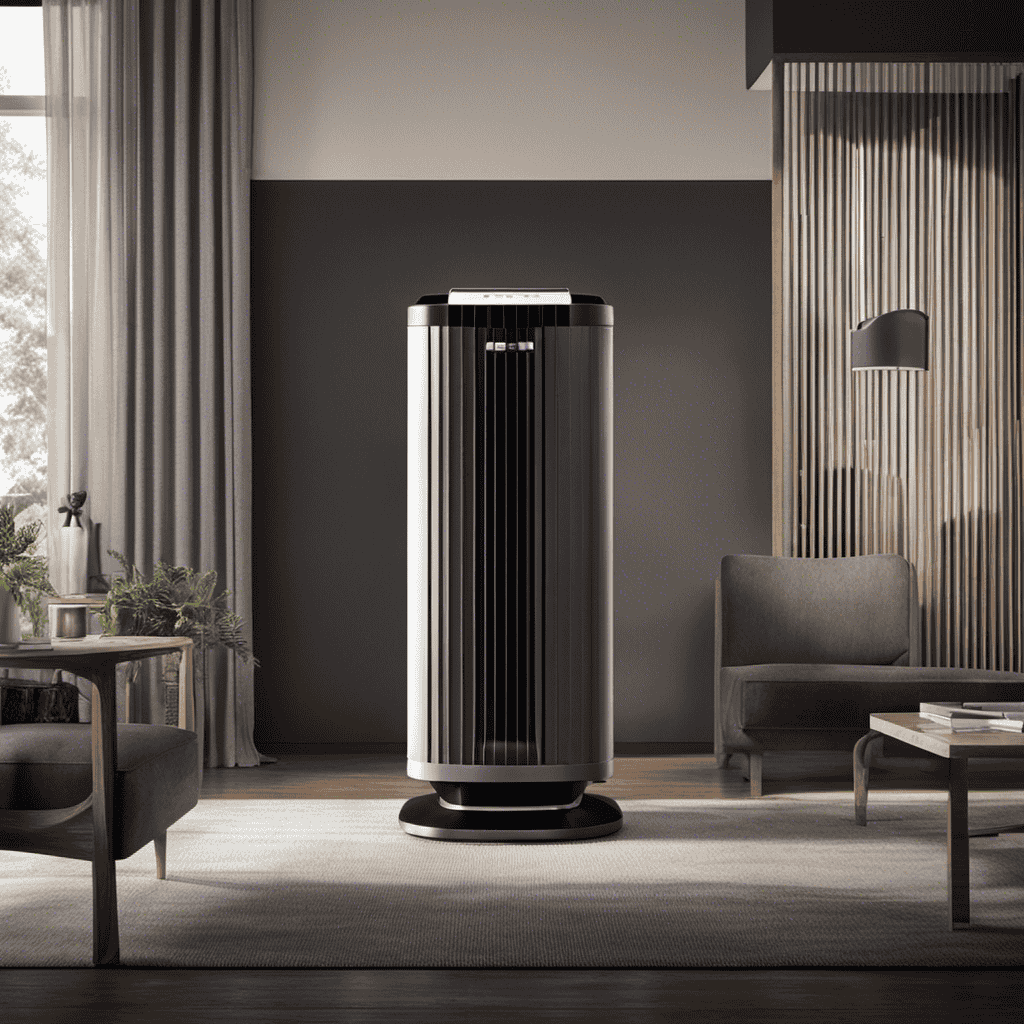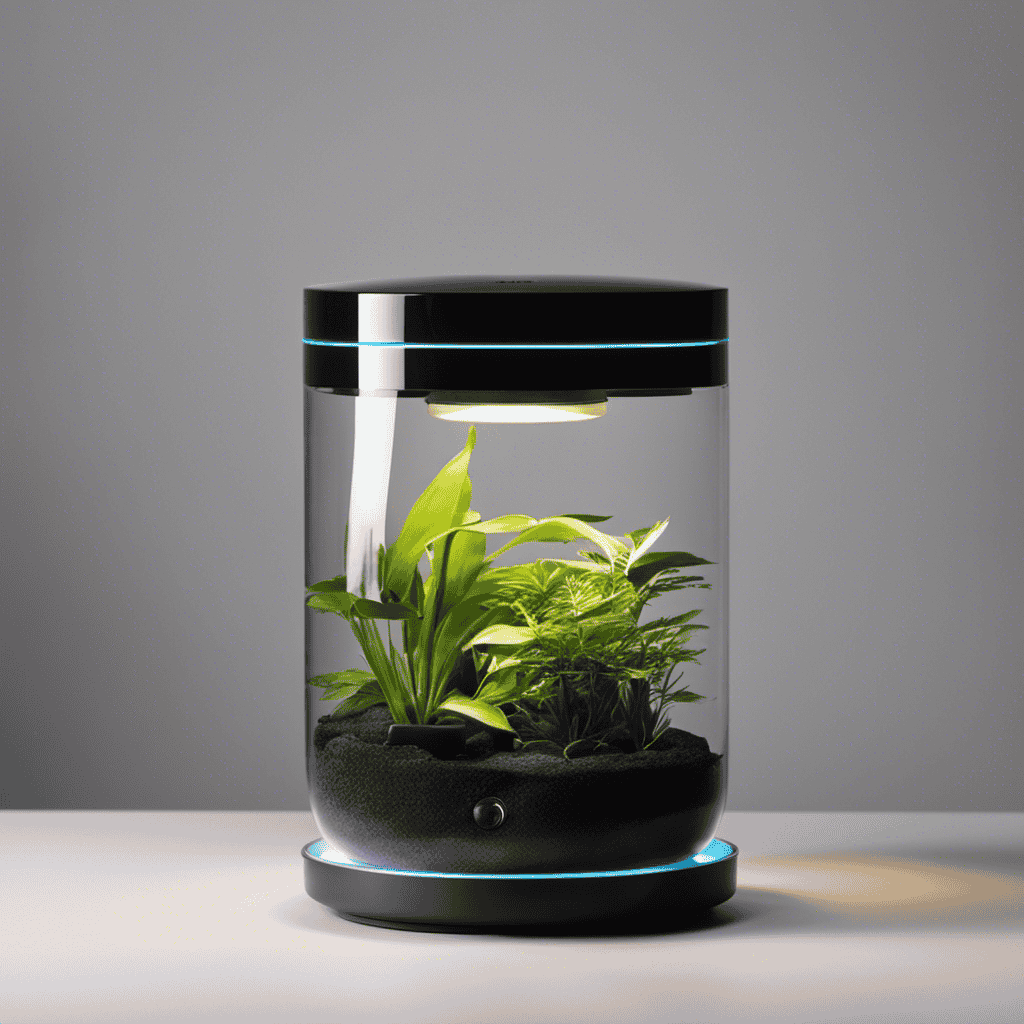Air purifiers with HEPA filters can help reduce airborne dust, dust mites, and their allergens, providing relief from allergy symptoms. They trap tiny particles like dust mite debris, skin flakes, and feces that trigger reactions. Choosing a purifier designed for allergens and maintaining it properly makes a big difference. While they’re effective, combining air purifiers with regular cleaning and humidity control offers the best results. Keep going to discover more ways to improve your indoor air quality.
Key Takeaways
- Yes, HEPA air purifiers can effectively trap dust mites and their allergens, reducing airborne particles.
- Properly selected air purifiers with HEPA filters improve indoor air quality and lessen allergy symptoms.
- Air purifiers alone are insufficient; combine with humidity control, cleaning, and allergen-proof bedding for best results.
- Regular filter replacement and maintenance ensure air purifiers effectively remove dust and mite allergens.
- Air purifiers help reduce airborne allergens, alleviating respiratory symptoms associated with dust and dust mite allergies.
Understanding Dust and Dust Mite Allergies

Dust and dust mite allergies occur when your immune system overreacts to tiny particles commonly found in your environment. These allergens often come from household dust, which can contain skin cells, pet dander, and dust mites. Indoor plants can help improve air quality but may also trap dust if not maintained properly. To reduce dust and dust mite exposure, controlling humidity is essential; keeping it between 40-50% makes the environment less hospitable for mites. Regularly dusting surfaces and choosing low-pollen, allergen-free indoor plants can help. Maintaining a clean, well-ventilated space minimizes allergen buildup. Additionally, being aware of indoor air pollution sources can further improve air quality and allergy management. Incorporating automation in cleaning technologies can also assist in maintaining a dust-free environment more efficiently. Moreover, advancements in AI-powered air purifiers offer promising solutions for detecting and reducing airborne allergens in real-time.
How Dust Mites Contribute to Allergic Reactions

Dust mites thrive in warm, humid environments like bedding and carpets, making these areas hotspots for allergens. As they feed on skin flakes, they release proteins that trigger allergic reactions in many people. These allergens can irritate your respiratory system, leading to symptoms like sneezing, coughing, and asthma attacks. Using essential oils, such as eucalyptus or tea tree oil, may help support respiratory health and reduce allergen presence. Proper air circulation can also help decrease dust mite populations by reducing humidity levels indoors. Additionally, maintaining a consistent humidity level below 50% can inhibit dust mite growth and improve air quality.
Dust Mites’ Habitats
Because dust mites thrive in environments rich in organic debris, they often inhabit your bedding, upholstered furniture, and carpets. Their biology depends on moisture, so household humidity plays a vital role in their habitat. Dust mites prefer humidity levels above 50%, where they reproduce quickly and survive longer. They feed on dead skin cells shed by humans and pets, making your home an ideal breeding ground. In areas with high humidity, dust mites multiply rapidly, increasing allergen levels. Conversely, reducing humidity can help limit their populations. Understanding dust mite biology and managing household humidity are essential steps in controlling their habitats. Controlling indoor humidity and regularly cleaning can help make your home less inviting to these tiny, allergen-producing creatures. Maintaining proper ventilation can further reduce indoor moisture levels, creating an environment less suitable for dust mites. Additionally, using air purifiers equipped with HEPA filters can help capture airborne dust mite allergens, providing relief for allergy sufferers. Using dehumidifiers can help maintain optimal humidity levels and further discourage dust mite growth, especially in damp areas of the home.
Allergens Released by Mites
While dust mites themselves are too tiny to notice, the proteins they release into the environment are a major trigger for allergic reactions. Mite behavior influences how these allergens disperse; they shed skin flakes and fecal particles containing potent proteins. When mites move, they disturb dust, releasing allergens into the air. This allergen dispersal occurs easily in bedding, upholstery, and carpets, where mites thrive. As you go about daily activities, these tiny particles become airborne, inhaled, and trigger your immune system’s allergic response. Understanding how mite behavior spreads allergens highlights the importance of reducing dust mite populations and minimizing allergen dispersal through cleaning and air filtration. This knowledge helps you better manage allergy symptoms caused by dust mites.
Impact on Respiratory Health
Dust mites and their allergens directly impact your respiratory health by triggering allergic reactions that affect the airways. When exposed, you might experience symptoms like sneezing, coughing, wheezing, or shortness of breath. This can worsen existing conditions such as asthma or lead to new dust allergy symptoms. To combat this, consider how an air purifier’s effectiveness can help reduce airborne dust mite particles. Keep in mind:
- Air purifiers with HEPA filters can trap small allergen particles effectively.
- Regular cleaning minimizes dust build-up, supporting respiratory health.
- Reducing humidity levels discourages mite proliferation, lessening allergen release.
- Using specialized treatments like allergen-proof covers can further reduce dust mite exposure.
Common Symptoms and Triggers
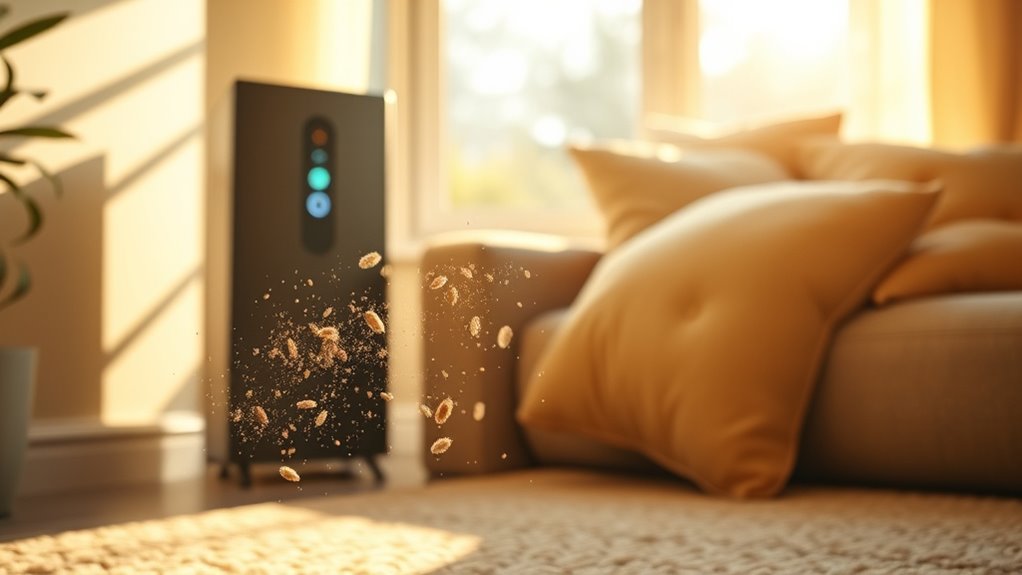
You might notice symptoms like sneezing, coughing, or itchy eyes when exposed to dust mites. Recognizing these reactions helps you identify triggers, which often include bedding, upholstery, and carpets. If you’re sensitive, these symptoms can be more intense or persistent, making awareness key to managing your allergies. Additionally, understanding the greatest happiness principle underlying many health-related decisions can guide you toward more effective allergy management strategies. Using an air purifier can significantly reduce airborne dust and allergens, providing relief for allergy sufferers, especially models equipped with HEPA filters that are proven to remove 99.97% of airborne pollutants. Being aware of allergy triggers can help you take proactive steps to minimize exposure and improve your quality of life.
Recognizing Allergic Reactions
Recognizing allergic reactions to dust and dust mites is essential for managing symptoms effectively. Common signs include sneezing, runny nose, itchy eyes, and coughing. You might also experience skin irritation or asthma flare-ups. To identify triggers, pay attention to exposure in areas with pet dander or mold spores, which can worsen reactions. Being aware of these symptoms helps you take action early. Look for patterns—do symptoms worsen after cleaning or in humid environments? Engaging in natural language processing can help reduce stress and improve overall well-being, which may positively influence allergy symptoms. Additionally, understanding electric dirt bike features may inspire you to explore eco-friendly transportation options that reduce indoor pollution. Incorporating proper air quality management techniques is crucial for minimizing dust mite proliferation indoors.
Common Dust Mite Triggers
Have you ever wondered what specifically triggers dust mite allergies? Dust mite biology reveals that their waste and body fragments are common allergens. These tiny creatures thrive in bedding, upholstery, and carpets, where they feed on skin flakes. When you breathe in dust mite particles, your immune system reacts, causing allergy symptoms. Regular cleaning helps reduce exposure, but for persistent issues, allergen immunotherapy can be effective, gradually desensitizing your immune response. Understanding these triggers is key to managing your allergy symptoms. Eliminating dust mites from your environment minimizes contact with their allergens, making air purifiers a helpful tool. By addressing the biological sources of dust mite allergens, you take a vital step toward relief and a healthier living space.
Symptoms in Sensitive Individuals
Many people with dust mite allergies experience a range of symptoms that can substantially affect daily life. Common signs include sneezing, nasal congestion, itchy eyes, and coughing. You might also notice wheezing or shortness of breath, especially if you’re sensitive to other triggers like pet dander or mold spores. These allergens can worsen symptoms and lead to asthma flare-ups. Be aware that:
- Pet dander can intensify nasal and respiratory issues
- Mold spores may cause coughing or wheezing
- Combined exposure can increase overall allergy severity
- Cake pops can be a fun treat at gatherings, but dust particles in the environment can settle on baked goods if proper hygiene isn’t maintained. Incorporating natural materials like bedding covers and air filters can reduce dust mite populations and improve indoor air quality for allergy sufferers.
If you’re sensitive, these triggers can make everyday activities difficult and disrupt sleep. Recognizing these symptoms and avoiding triggers is essential for managing your allergy symptoms effectively.
The Science Behind Air Purifiers
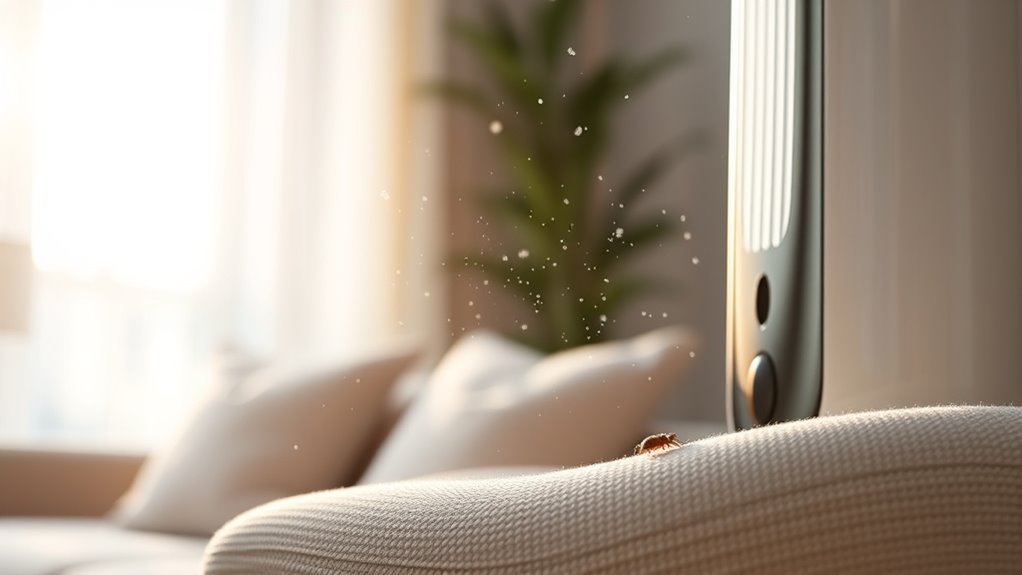
Air purifiers work by actively removing airborne particles that trigger allergy symptoms, such as dust mites and their allergens. They use advanced air purifier technology, including HEPA filters and ionizers, to trap tiny particles you might not see. Understanding dust mite biology helps explain how these devices work; dust mites produce waste and shed skin that become airborne, causing allergic reactions. When your air purifier runs, it captures these microscopic allergens, reducing their presence in your indoor environment. This process can substantially lessen allergy symptoms by decreasing the number of airborne dust mite particles. The effectiveness depends on the purifier’s design and how well it filters out small particles, with features like filter capacity playing a crucial role in maintaining consistent air quality. Additionally, selecting a model with proper room coverage size ensures optimal performance in your space. By understanding the science, you can see how air purifiers actively improve indoor air quality for allergy sufferers.
Types of Air Purifiers and Their Effectiveness
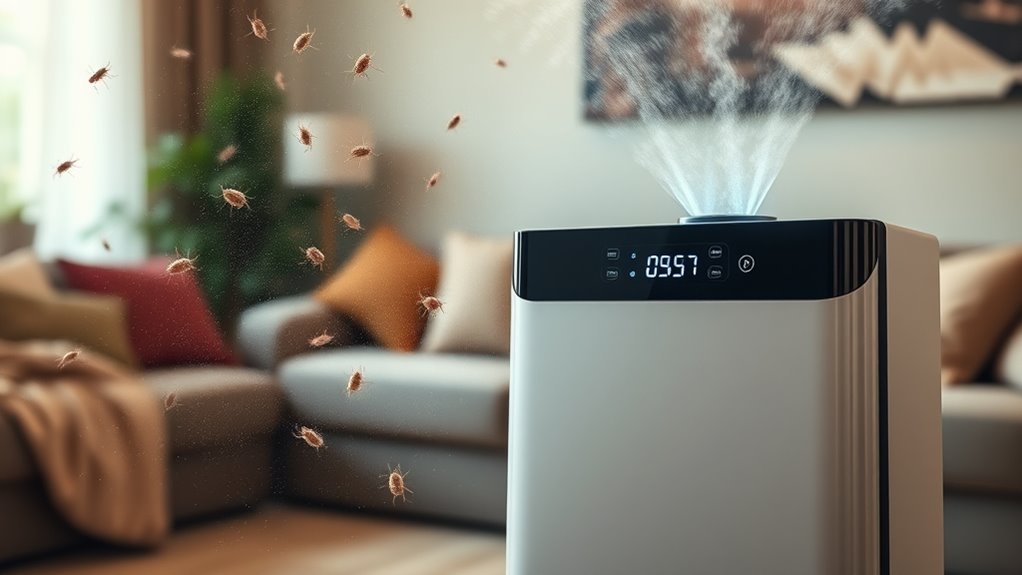
You should consider the efficiency of HEPA filters, which can trap tiny dust and mite particles effectively. Activated carbon filters also play a key role by removing odors and airborne chemicals. Together, these features can substantially improve your indoor air quality and reduce allergy symptoms. Additionally, using performance-enhanced air purifiers designed for allergy relief can provide even more targeted benefits. Investing in air quality solutions can further support your efforts to create a healthier indoor environment. For optimal results, choosing an air purifier with multi-stage filtration can enhance overall effectiveness.
HEPA Filter Efficiency
HEPA filters are essential components of air purifiers designed to capture tiny particles, including dust mites and their allergens. Their high efficiency means they can remove at least 99.97% of particles as small as 0.3 microns, notably improving your air quality. To maximize their effectiveness, look for units with certified HEPA filters. Keep in mind:
- Proper maintenance is key—replace filters regularly to maintain peak performance.
- HEPA filters excel at trapping allergens but don’t remove odors or chemicals.
- Combining a HEPA filter with other air purification technologies can offer all-encompassing protection.
- Advances in machine learning algorithms enable smarter air purifiers that adapt to your environment for improved allergen removal.
Activated Carbon Benefits
While HEPA filters effectively trap tiny particles like dust mites and their allergens, they don’t address odors or chemical pollutants. That’s where activated carbon comes in. Activated carbon filters absorb odors, volatile organic compounds (VOCs), and chemical fumes, making your indoor air fresher and safer. They’re especially useful if you notice persistent smells or are sensitive to chemical irritants. To help visualize, here’s a comparison:
| Feature | HEPA Filtration | Activated Carbon | Combined Effect |
|---|---|---|---|
| Traps tiny particles | Yes | No | Yes |
| Removes odors | No | Yes | Yes |
| Absorbs chemicals | No | Yes | Yes |
| Best for allergens | Yes | No | Partial |
| Best for chemical fumes | No | Yes | Partial |
Using both types enhances overall air quality effectively.
How Air Purifiers Capture Dust and Allergens

Air purifiers effectively remove dust and allergens from indoor air by using advanced filtration systems that trap tiny particles. The key is their ability to target allergen particle size, which can be as small as 0.3 microns. To keep your air purifier working at its best, regular air purifier maintenance is essential. This includes replacing or cleaning filters as recommended. HEPA filters are especially effective at capturing:
- Dust mites
- Pet dander
- Mold spores
These filters can trap particles that cause allergies, preventing them from circulating. The efficiency depends on the filter’s quality and proper maintenance. By consistently maintaining your device, you guarantee it continues to capture allergens effectively, improving your indoor air quality and alleviating allergy symptoms.
Limitations of Air Purifiers in Allergy Relief
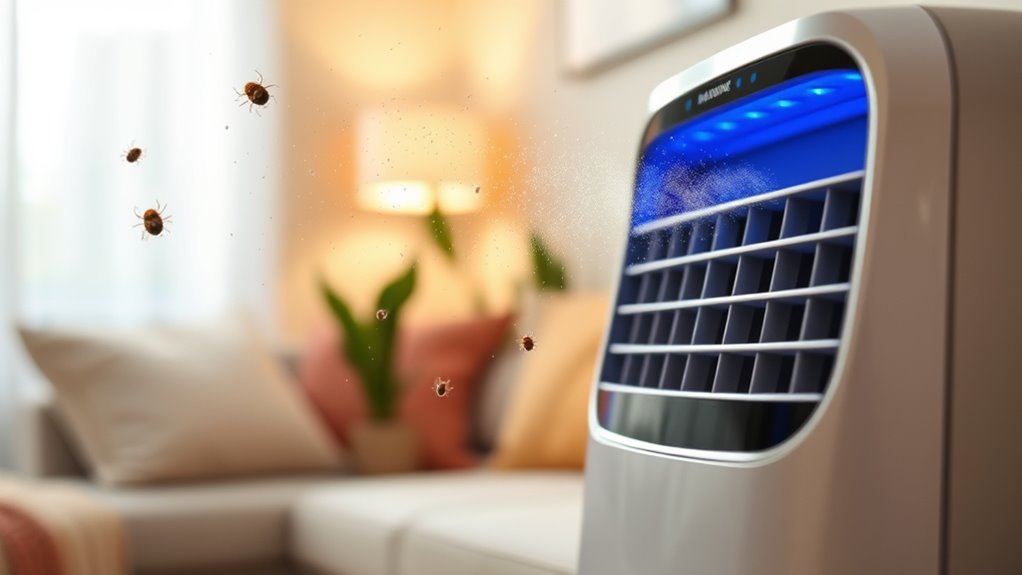
Although air purifiers are effective at capturing many airborne allergens, they do have limitations when it comes to providing complete allergy relief. They mainly filter particles in the air but don’t eliminate allergens hiding in your surroundings. For example, pollen avoidance isn’t guaranteed just by running an air purifier. Mold prevention is also limited, since mold spores often grow on surfaces outside the purifier’s reach. Visualize this:
| Air Purifier Limitations | External Factors | Residual Allergens |
|---|---|---|
| Can’t stop pollen from entering | Pollen in outdoor air | Pollen stuck in fabrics |
| Struggles with mold spores on surfaces | Mold growth in damp areas | Mold spores in hidden spots |
| Limited to airborne particles | Mold and pollen outside purifier’s scope | Allergens embedded in soft furnishings |
In short, air purifiers help but aren’t a complete solution for allergy relief.
Additional Strategies to Minimize Dust and Dust Mites
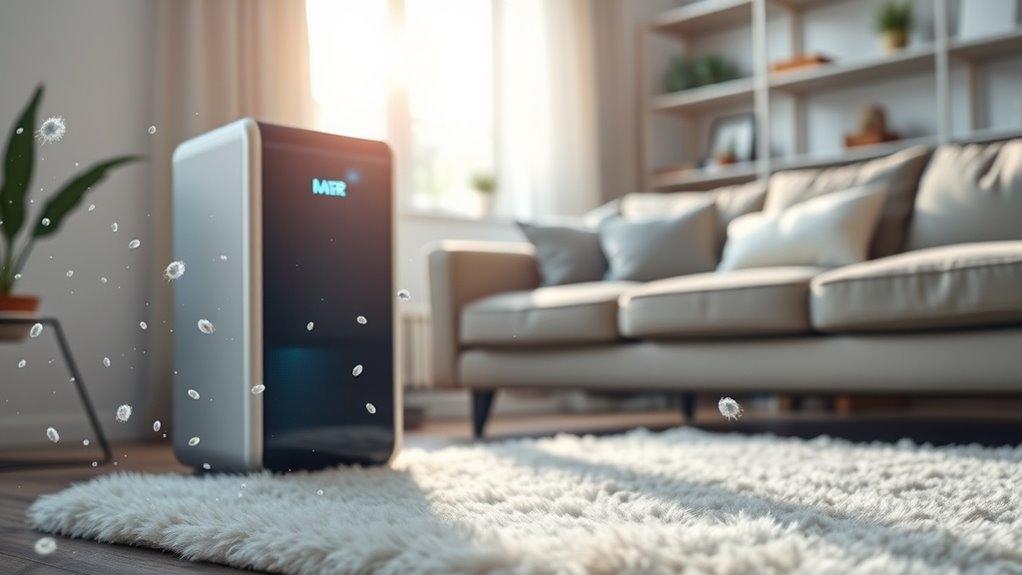
To effectively reduce dust and dust mites in your home, you need to implement multiple strategies beyond relying on air purifiers. Regular HVAC system maintenance is essential to keep dust from circulating and to ensure filters are working efficiently. Controlling humidity levels—keeping it between 30-50%—limits dust mite growth, since they thrive in moist environments. Additionally, consider these steps:
Maintaining HVAC, controlling humidity, and regular cleaning reduce dust mites and improve indoor air quality.
- Wash bedding weekly in hot water
- Use allergen-proof mattress and pillow covers
- Vacuum carpets and upholstery regularly with a HEPA filter vacuum
These measures, combined with proper humidity control, help minimize dust and dust mites, reducing allergy symptoms and improving your indoor air quality.
Choosing the Right Air Purifier for Allergies

Selecting the right air purifier can make a significant difference in reducing airborne allergens and improving your indoor air quality. To do this effectively, consider models with HEPA filters, which can trap tiny particles like dust mite debris, reducing your exposure. Understanding the dust mite lifecycle is key—these pests produce allergen-carrying feces and body fragments that worsen your allergen immune response. Choose an air purifier capable of continuously filtering the air, especially in bedrooms and common areas. Look for features like adjustable fan speeds and proper room size ratings. By targeting airborne dust mite allergens directly, the right purifier can help lessen your allergy symptoms and create a healthier indoor environment.
Tips for Maintaining Clean Indoor Air
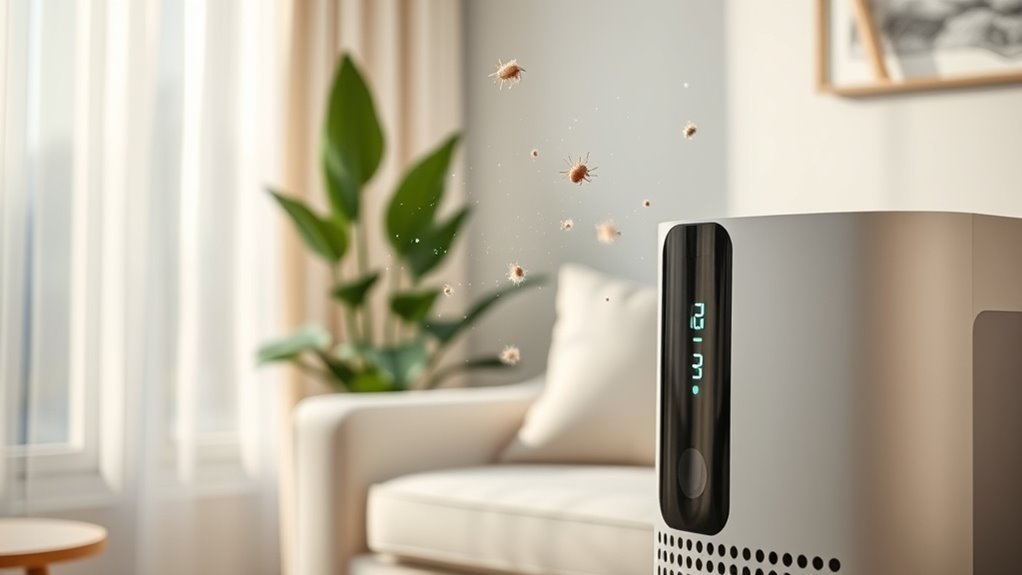
Keeping the air inside your home clean requires consistent effort and smart habits. Understanding dust mite biology helps you target their environment more effectively. To reduce allergens, focus on controlling indoor humidity, as dust mites thrive in humid conditions. Aim to keep humidity levels between 30-50% using dehumidifiers or air conditioners. Regular cleaning is essential; vacuum with a HEPA filter, wash bedding weekly, and dust surfaces often. Here are some tips to maintain clean indoor air:
- Keep indoor humidity low to inhibit dust mite growth
- Use allergen-proof covers on bedding and furniture
- Ventilate rooms regularly to reduce indoor pollutants
Frequently Asked Questions
Can Air Purifiers Eliminate All Dust Mites Completely?
You wonder if air purifiers can eliminate all dust mites completely. While they markedly improve air quality, they can’t remove every dust mite or their allergens. Regular vacuuming improves dust mite prevention and reduces their presence in your home. Combining vacuuming effectiveness with an air purifier helps minimize dust mites and their allergens, but complete elimination is unlikely. Consistent cleaning and air filtration create a healthier environment for allergy sufferers.
Are HEPA Filters the Only Effective Option for Dust Allergy Relief?
Imagine you’re in the 1800s, wondering if HEPA filters are your only hope. Today, you have options like UV filters and air quality monitoring to combat dust allergies. HEPA filters are highly effective at trapping dust mites, but UV filters can neutralize germs, adding extra protection. To maximize relief, choose a purifier with HEPA and UV features, and keep an eye on air quality to guarantee your environment stays allergen-free.
How Often Should I Replace or Clean Air Purifier Filters?
You should check your air purifier’s filter maintenance guidelines regularly to determine the right replacement frequency. Typically, filters need replacing every 3 to 6 months, but this varies based on usage and indoor air quality. To keep your device working efficiently, clean or replace filters promptly when they become dirty or clogged. Regular maintenance ensures peak performance and helps reduce dust and allergens in your home.
Do Air Purifiers Remove Airborne Mold Spores Associated With Dust Allergies?
Air purifier efficiency varies, but many models can effectively remove airborne mold spores associated with dust allergies. Look for purifiers with HEPA filters, as they trap tiny particles like mold spores, improving indoor air quality. While they don’t eliminate mold growth itself, air purifiers considerably reduce airborne mold spore levels, providing relief. Regular filter changes enhance mold spore removal, ensuring your device maintains maximum efficiency and helps manage allergy symptoms.
Can Air Purifiers Help Reduce Allergy Symptoms in Pets Affected by Dust Mites?
You can use air purifiers as part of your pet allergy management to help reduce allergy symptoms. They improve indoor air quality by filtering out dust mite allergens and pet dander, making the environment more comfortable for your furry friend. While they’re not a complete solution, air purifiers can markedly lessen airborne allergens, helping your pet breathe easier and easing allergy symptoms.
Conclusion
While air purifiers can be a helpful shield against dust and dust mite allergens, they’re just one part of the battle. Think of them as a trusty umbrella—helpful, but not foolproof in a storm. To truly breathe easier, combine an air purifier with regular cleaning, proper ventilation, and allergen-proof bedding. Together, these steps create a safer indoor environment, making your home a haven where allergens are kept at bay—and your breathing is finally at ease.
